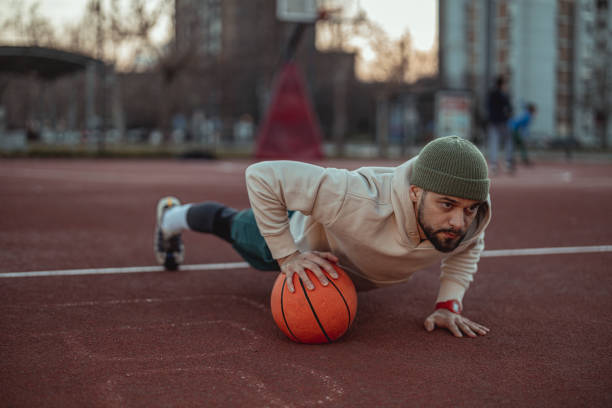In the dynamic and physically demanding sport of basketball, strength training plays a crucial role in enhancing performance, preventing injuries, and maximizing athletic potential.
From improving explosive power to increasing agility and resilience on the court, basketball strength training is essential for players of all levels looking to elevate their game.
In this comprehensive guide, we'll explore the fundamentals of basketball strength training, providing expert insights, techniques, and exercises to help you unlock your full potential on the hardwood.
Why is Strength Training Important for Basketball?
Basketball is a game that requires a diverse skill set, including speed, agility, endurance, and strength.
While traditional skill training focuses on shooting, dribbling, and defensive techniques, strength training addresses the physical attributes necessary for success on the court.
By developing strength in key muscle groups, basketball players can improve their ability to jump higher, move quicker, and outmuscle opponents for rebounds and loose balls.
Key Components of Basketball Strength Training
Effective basketball strength training programs incorporate a variety of exercises targeting different muscle groups and movement patterns. These include;
- Lower Body Strength: Exercises like squats, lunges, and deadlifts are essential for building lower body strength and power, enabling players to explode off the ground for rebounds, drives, and defensive stops.
- Core Stability: A strong core is vital for maintaining balance, stability, and control during explosive movements and changes of direction on the court. Planks, Russian twists, and medicine ball exercises are excellent for strengthening the core muscles.
- Upper Body Strength: While basketball is primarily a lower body-dominant sport, upper body strength is still important for shooting, passing, and defending. Incorporate exercises like push-ups, pull-ups, and shoulder presses to develop upper body strength and muscular endurance.
- Plyometrics and Explosive Drills: Plyometric exercises such as box jumps, depth jumps, and lateral bounds are effective for improving reactive strength and explosiveness, crucial for quick movements and vertical jumping ability in basketball.
Read Also: list-of-European-clubs-that-offer-basketball-scholarship
Benefits of Basketball Strength Training
Basketball strength training offers a multitude of benefits for players, including;
- Increased Power and Explosiveness: Stronger muscles generate more force, allowing players to explode off the ground for rebounds, dunks, and fast breaks.
- Improved Endurance: Strength training enhances muscular endurance, enabling players to maintain peak performance throughout the duration of a game and reduce the risk of late-game fatigue.
- Injury Prevention: Strengthening muscles and connective tissues can help prevent common basketball injuries such as sprains, strains, and ligament tears by providing greater support and stability to joints.
- Enhanced Physicality: Developing strength and muscle mass can improve a player's ability to withstand physical contact and compete effectively in the paint, whether it's battling for rebounds or driving to the basket.
Incorporating Basketball Strength Training into Your Routine
To maximize the benefits of basketball strength training, it's essential to design a structured and progressive workout program tailored to your individual needs and goals.
Here are some tips for incorporating strength training into your routine:
- Start with a thorough warm-up to prepare your body for the demands of strength training and reduce the risk of injury.
- Focus on compound exercises that target multiple muscle groups simultaneously, such as squats, deadlifts, and pull-ups.
- Gradually increase the intensity and volume of your workouts over time to challenge your muscles and continue making progress.
- Incorporate rest and recovery days into your training schedule to allow your muscles time to repair and grow stronger.
- Listen to your body and adjust your training program as needed based on your progress, recovery, and performance on the court.
Read Also: A-comprehensive-guide-to-basketball-injury-prevention
Offseason Basketball Strength Training
This is crucial for player development and performance enhancement.
It involves building functional strength, improving agility, preventing injuries, enhancing endurance, and fostering mental toughness.
By dedicating time to structured workouts and drills during the offseason, players can elevate their on-court skills, reduce the risk of injuries, and cultivate the physical and mental attributes needed for success in basketball.
Here's a sample basketball strength training workout plan;
Day 1: Lower Body Focus
- Warm-up: 5-10 minutes of dynamic stretches and light jogging.
- Squats: 4 sets x 8-10 reps
- Deadlifts: 3 sets x 8-10 reps
- Lunges (Walking or Stationary): 3 sets x 10 reps each leg
- Box Jumps: 3 sets x 8-10 reps
- Calf Raises: 3 sets x 12-15 reps
- Core Exercises (Planks, Russian Twists, Leg Raises): 3 sets x 12-15 reps each
Day 2: Upper Body Focus
- Warm-up: 5-10 minutes of dynamic stretches and light jogging.
- Bench Press: 4 sets x 8-10 reps
- Pull-Ups or Lat Pulldowns: 3 sets x 8-10 reps
- Shoulder Press: 3 sets x 8-10 reps
- Bent-Over Rows: 3 sets x 8-10 reps
- Dumbbell Bicep Curls: 3 sets x 10-12 reps
- Tricep Dips or Skull Crushers: 3 sets x 10-12 reps
Day 3: Rest or Active Recovery
Engage in light cardio, yoga, or foam rolling to promote recovery and flexibility.
Day 4: Lower Body Plyometrics
- Warm-up: 5-10 minutes of dynamic stretches and light jogging.
- Box Jumps: 3 sets x 8-10 reps
- Lateral Bounds: 3 sets x 10 reps each side
- Depth Jumps: 3 sets x 8-10 reps
- Split Squat Jumps: 3 sets x 10 reps each leg
- Agility Ladder Drills: 10-15 minutes focusing on quick footwork and change of direction.
Day 5: Full Body Strength
- Warm-up: 5-10 minutes of dynamic stretches and light jogging.
- Squat Variations (Front Squats, Goblet Squats): 3 sets x 8-10 reps
- Romanian Deadlifts: 3 sets x 8-10 reps
- Push-Ups: 3 sets x 10-12 reps
- Pull-Ups or Rows: 3 sets x 8-10 reps
- Medicine Ball Slams: 3 sets x 10-12 reps
- Plank Variations (Side Planks, Plank with Arm/Leg Raise): 3 sets x 30-45 seconds each
Day 6: Rest or Active Recovery
Engage in light cardio, yoga, or foam rolling to promote recovery and flexibility.
Day 7: Agility and Conditioning
- Warm-up: 5-10 minutes of dynamic stretches and light jogging.
- Squat Variations (Front Squats, Goblet Squats): 3 sets x 8-10 reps
- Romanian Deadlifts: 3 sets x 8-10 reps
- Push-Ups: 3 sets x 10-12 reps
- Pull-Ups or Rows: 3 sets x 8-10 reps
- Medicine Ball Slams: 3 sets x 10-12 reps
- Plank Variations (Side Planks, Plank with Arm/Leg Raise): 3 sets x 30-45 seconds each
Remember to listen to your body, adjust weights and repetitions as needed, and prioritize proper form to prevent injuries.
Additionally, adequate rest and recovery are essential for maximizing the benefits of your strength training regimen.
Conclusion
Basketball strength training is a cornerstone of athletic development for players looking to excel on the court.
By incorporating a well-rounded strength training program into your routine, you can improve your physical capabilities, reduce the risk of injury, and take your game to the next level.
Whether you're a beginner or a seasoned veteran, prioritizing strength training will undoubtedly pay dividends in your basketball journey.
Start incorporating these principles into your training regimen today and watch as your game reaches new heights.

 Afiemo
Afiemo




